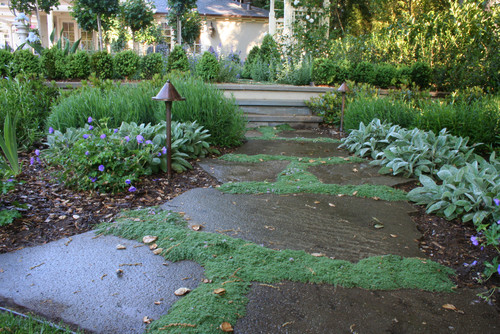Thinking about decorating and beautifying your yard?
Perhaps adding or restoring the walkways can change the look of it. If well-conceived and constructed they can increase significantly the appearance, function and value of your property.

Photo by Frank & Grossman Landscape Contractors, Inc. – Browse landscaping photos
The Main Characteristics of a Good Walkway
In case you want to build a new path through your yard, first you need to know which is the best route. It’s actually quite simple to set this route, following the paths made through the garden. If you analyze the patterns and foot traffic needs, you will find the best route, materials and layout for the walkways.
In fact, a good walkway should be:
- – Minimum width 30-inch (75 cm)
- – For persons with disabilities who use wheelchairs – minimum width 4-ft (1.2 m)
- – The slope should not be steeper than 5% (1:20)
However, apart from compliance with these minimum dimensions you have to consider also other aspects of this project. Among other things, the best is to not overdo building large impermeable surfaces of walkways, much larger than you actually need.
Maximizing the permeable surfaces such as grass or planted surfaces will reduce a lot the rainwater run-off that can affect pretty bad the natural water bodies and overflow the sewer systems, including the municipal one.
Grass and planted areas also let rainwater to penetrate the soil helping your garden vegetation to grow. So, it is wise to use other hard and impermeable surfaces for foot traffic such as patios or driveways than to build a very extensive walkway surface. In this way, you will avoid traffic duplication and will have a beautiful green yard.
Choosing permeable construction materials for your walkway surface is another smart way to allow the rainwater to penetrate into the soil.
a) For the main walkway, which is between the street and your house and that you use more frequently than other ones you need a firm, durable and if it is possible, a permeable surface. An excellent choice can be interlock pavers that come in a wide range of colors and shapes, are modular and also permeable. In addition, they can be repaired easily.
b) For the other walkways that you use less frequently such a path through landscaping and woodland or the link between the backyard to the front yard, you should take in consideration using loose materials such as pea gravel, river stone, cobblestone, stone dust or crushed brick. These materials are indeed permeable but not firm enough for people with disabilities. They also require continuous maintenance such as repositioning and weeding. However, using edging construction materials may help keeping them in place.
Think Green when Building a Walkway
Choosing only materials from local suppliers or local sources such as gravel, sand and stone or interlock pavers, which are manufactured in your area, will reduce significantly the environmental impact. Costs and energy used to transport these materials will be greatly diminished.
Another way to protect the environment is the use of re-used and recycled materials.
Harmony and Balance in Feng Shui Gardens | Smart Principles (howtobuildahouseblog.com)


